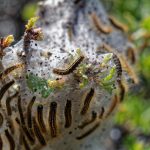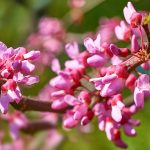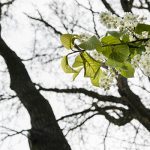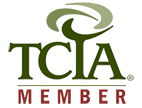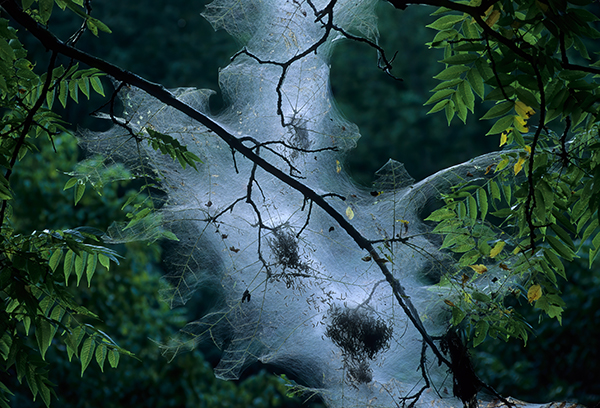
Does your Chicagoland backyard look like a scene from a horror movie? Don’t worry, this blog will explain how to deal with these nuisance insect pests called tent caterpillars
The beginning of the summer is a great time in the Chicago area. The warm weather is back, and the trees are in full bloom for the growing season. However, the return of warm weather and freshly grown foliage also means that those annoying pests that can damage your plants are back. With the return of the growing season and the pests that come with it, we have returned with our series on tree diseases and insect pests of the Chicago area to take a closer look at a pest that defoliates trees, tent caterpillars.
Tent caterpillars (Mamacosoma spp.) are moth larvae that live in trees in the larval stage and feed on young leaves and buds. There are twenty-six known species of tent caterpillars throughout the world, 6 of which are native to North America. Tent caterpillars live in groups that can defoliate trees quickly, and they can even defoliate acres of forests if unchecked. Most trees that are affected by tent caterpillars survive without permanent harm, but a tree may die if the tent caterpillars return and defoliate it year after year.
Tent caterpillars are named for the silk tent-like nests they make in the tree branches. These tents appear early in the spring and they are easy to spot. The caterpillars themselves are also easy to identify as most species have dark colored bodies with bright orange hair and either a white stripe or white dots going down the center of their backs. Some species of tent caterpillars look different such as the western tent caterpillar which has a pale blue body and two black stripes down the center of its back. Tent caterpillars almost always live and eat in groups which also makes them easy to spot. The moths of tent caterpillars are relatively nondescript as the males and females are both light brown in color with tufts of hair on their thorax.
In this guide, we will discuss the lifecycle of tent caterpillars and the damage they cause to trees, as well as how to control tent caterpillar infestations and protect your trees from damage. Our arborists at Hendricksen Tree Care provide complete tree treatment and maintenance services including diagnosing and treating insect infestations. If you believe your trees are being affected by tent caterpillars, we will diagnose the problem and come up with a tent caterpillar control solution to protect your trees.
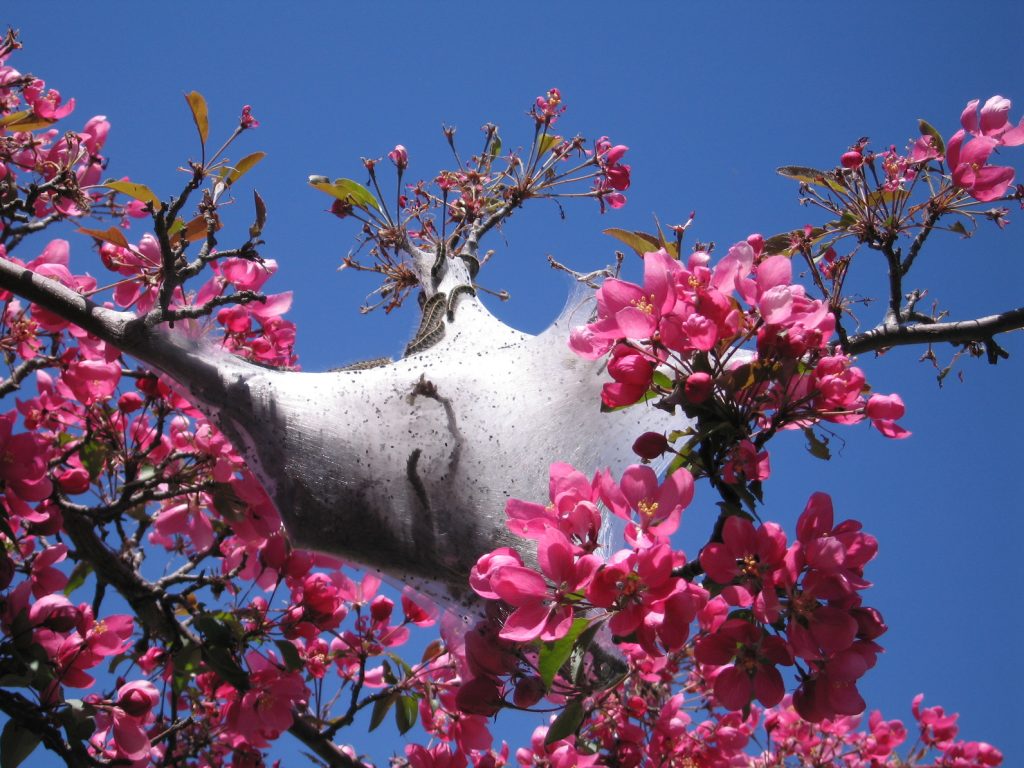
Tent caterpillar nests tend to form in the early Spring, and although not usually deadly to trees, can be a real eye sore in your Spring landscaping
Most tent caterpillar species overwinter in egg masses formed by female moths the previous season. The female moth will deposit its eggs and use a sticky substance called spumaline to hold the eggs together in a mass. The spumaline keeps the eggs hydrated, protects them from cold winter weather, and prevents insects like wasps from eating the eggs. The egg mass is usually attached to bark or twigs and it is dark brown or gray in color. Each egg mass can hold 150 to 400 eggs.
Tents
In the early spring, the tent caterpillars hatch, usually at the same time the leaves of the host tree begin to appear. The larvae begin building their silk tents almost immediately which serve as a shelter for the caterpillars between feedings. These tents are generally built in the spaces between smaller limbs, and they are always positioned in an area where they are hit by the morning sun. This is important because tent caterpillars need to bask in the sun to raise their body temperatures high enough for them to be able to digest.
The tents are made with layers of silk and contain multiple compartments. Tent caterpillars will congregate in the top compartment when they need warmth from the sun and depending on their body temperature, they may move to lower compartments that get progressively cooler.
Feeding
Tent caterpillar larvae must feed exclusively on new leaves to aid in their larval development which is why they are active in the early spring. During the day, tent caterpillars will leave their tents as a group to find a feeding site on the tree. Once they are done feeding, the group returns to the tent to bask in the sun and digest. They may leave the tents as a group several times a day to feed and return to their tent. Some species of tent caterpillar, such as the forest tent caterpillar, may have several resting sites and not return to the same tent every time.
As tent caterpillars search for food, they leave a pheromone trail that helps them get back to their tent. When a caterpillar finds a feeding site, it will return to the tent and leave a different pheromone trail that leads other caterpillars in the tent to the site. Much of the materials in the leaves eaten by tent caterpillars are nondigestive which means that they produce a high volume of fecal pellets. These fecal pellets drop out of the trees from their feeding sites.
Larval Development and Pupation
Most species of tent caterpillars go through five or six growth stages, or instars. In each stage, the caterpillar molts and grows, and its color pattern may also change. It usually takes seven to eight weeks for tent caterpillars to fully develop in their larval stage and they end up 1¾ to 2 inches long. Tent caterpillars eat the most in their last instar as about 80 percent of all food eaten during their larval development is done in this stage.
Shortly after the tent caterpillars become fully grown, they will begin looking for areas to pupate. Some may pupate under bark or leaves on the host tree while others may leave the tree to pupate under the eaves of houses or in dead plant materials on the ground. Their cocoons are made from silk and a white or yellowish crystalline substance that can irritate human skin. In about two weeks, they emerge from their cocoons as adult moths.
Adult Stage
The moths of tent caterpillars do not feed but spend their short adult lives mating. The female moth releases a pheromone after emerging from the cocoon to attract males. After mating, the female will deposit its eggs on the bark or twig of a tree and cover the eggs with spumaline to form the egg mass which will overwinter and hatch the following spring.
The female dies shortly after forming the egg mass which can occur within 24 hours of emerging from the cocoon. Adult males typically only live for a few days to a week. There is only one generation per year for all tent caterpillar species.
Types of Tent Caterpillars
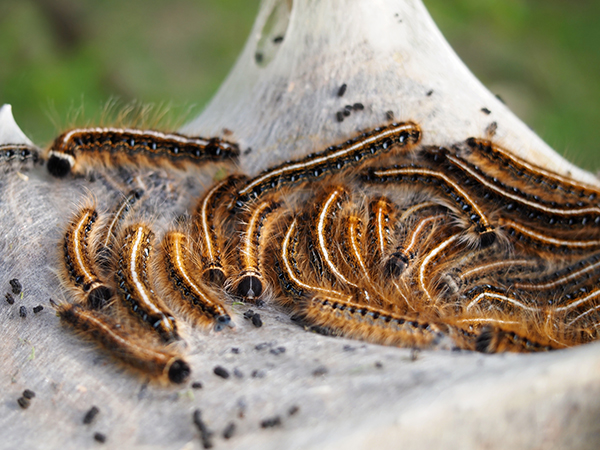
Closeup of the Eastern tent caterpillar
As mentioned above, there are twenty-six known species of tent caterpillars, six of which can be found in North America. Below are the tent caterpillar species in North America:
- Eastern tent caterpillar: The eastern tent caterpillar (Malacosoma americanum) is found in the eastern part of the United States and southern Canada. These caterpillars have black bodies with blue spots running along each side of the body, and a solid white stripe down the center of their backs. The adult moths are reddish brown in color with two diagonal white stripes on each wing. They typically use fruit trees like cherry and apple trees as their host trees but are also known to use shade trees.
- Western tent caterpillar: The western tent caterpillar (Malacosoma californicum) is found throughout the northern and western U.S. as well as parts of Canada. These caterpillars have slate blue bodies with orange spots and two black stripes running down their backs. The adult moths are orangish brown in color and their wings have two narrow yellow lines. Western tent caterpillars use many different trees as their host trees including oak trees, willows, poplars, birch trees, apple trees, cherry trees, plum trees, and cottonwoods.
- Forest tent caterpillar: Forest tent caterpillars (Malacosoma disstria) can be found anywhere in the U.S. and Canada where there are hardwood trees. Unlike other tent caterpillars, forest tent caterpillars build silken mats instead of full tents on branch surfaces. As mentioned above, these caterpillars may form several of these mats in different places on the host tree. The caterpillars look very similar to eastern tent caterpillars except that they have white spots running down their backs instead of a solid white line, and the adult moths are tan in color with two dark bands on their wings. These caterpillars affect hardwood tree species such as oak, hawthorn, maple, aspen, and wild cherry.
- Southwestern tent caterpillar: The southwestern tent caterpillar (Malacosoma incurva) is found in the southwestern U.S. The larvae look similar to that of the western tent caterpillar, but the adult moth looks different than the adults of other tent caterpillars. Southwestern tent moths are cream colored and hairier than the other tent moths. The southwestern tent caterpillar feeds on cottonwoods, willows, plum trees, cherry trees, almond trees, apricot trees, and more.
- Fall webworm: The fall webworm (Hyphantria cunae) is found throughout the U.S. and Mexico and it feeds on more than 80 tree species. Webworms build their tents at the ends of tree branches and include the leaves in their tent while other tent caterpillars build their tents in the crotch of small branches. In the larval stage, webworms may be yellow or green in color with yellow stripes on the sides of the body and a black stripe down the back. Webworm moths are white with dark spots on the wings.
Damage Caused by Tent Caterpillars
The only damage caused by tent caterpillars is the defoliation of the affected trees. In most cases, the tent caterpillars will defoliate a few branches on a tree before they pupate, and the tree will regenerate new leaves without suffering any real damage. However, the damage can be much worse in severe cases.
The yearly populations of tent caterpillars tend to be boom or bust, and in the boom years they can cause a lot of damage. The forest tent caterpillar especially is known to have boom populations in which a large infestation can defoliate acres of forests. Fortunately, these large outbreaks never last more than 2-3 years as disease, parasitoids, and starvation from quick defoliation decimate their population.
If you have trees affected by tent caterpillars, there is a good chance your tree will survive unharmed and regenerate the lost leaves. However, it is possible for tent caterpillars to kill branches of the tree and even the tree itself if they defoliate the same tree several years in a row or if the tree is stressed due to drought or disease. If you have a stressed tree or a tree that has been defoliated by tent caterpillars a couple years in a row, you should take action to control their population.
The following are the signs of a tent caterpillar infestation:
- Brown or gray egg masses on twigs
- Silk tents at the crotch of small limbs
- Groups of caterpillars moving together on the tree
- Defoliated young twigs and branches
- White or yellow cocoons under the bark
Tent Caterpillar Control
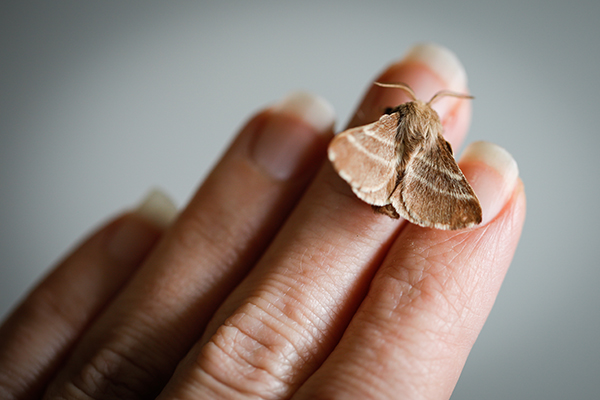
An adult tent caterpillar moth
There are several effective methods of tent caterpillar control that you can use to minimize their damage. Depending on how badly your trees are affected, it may not be necessary to take any action. Our professional arborists at Hendricksen Tree Care can assess the extent of the problem and recommend an appropriate course of action.
- Tree trimming: You can physically remove tent caterpillars by pruning affected branches. During the winter, you can prune twigs that contain the egg masses, and, in the spring, you can prune twigs and branches where the tents appear. If the tents appear in areas that cannot be pruned, you can remove them using a pole or a high-pressure hose. You can hire a professional arborist if you do not feel comfortable handling the tree trimming.
- Biological control: There are several natural predators of tent caterpillars that help keep their populations under control. Parasitic wasps and soil dwelling bacterium may attack tent caterpillars and they are also eaten by birds and other insects including paper wasps and assassin bugs.
- Chemical treatments: You can help keep tent caterpillars under control with various chemical treatments and insecticides. One thing to keep in mind is that insecticide treatments are largely useless once the tent caterpillars reach their final stage of larval development, so any of these treatments need to be done early in the spring.
- Spray tents in the morning or evening when the caterpillars congregate.
- Spray egg masses with dormant oil during the winter.
- Spray leaves with insecticidal sprays that include the Bacillus thuringiensis This bacterium is parasitic to tent caterpillars. Make sure to spray leaves thoroughly so that it is eaten by the tent caterpillars. This treatment is effective when the larvae are in their earliest stages.
- Consult an arborist: Tree service professionals like Hendricksen Tree Care can recommend an effective solution to the problem based on the level of infestation and the damage caused.
Tent Caterpillar Treatment and Control from Hendricksen Tree Care
While tent caterpillars are not a cause for concern in some cases, they can be in certain circumstances such as repeated infestations or infestations of a stressed tree. Even if they pose no long-term damage to your trees, maybe you don’t want them defoliating an ornamental tree on your property. If you find silk tents on your trees and aren’t sure what to do, contact our professionals at Hendricksen Tree Care.
Our arborists will inspect your trees to determine the type of infestation as well as the extent. We can then advise you on the best action to take depending on the situation and your budget. We provide tree trimming services in which we will remove the affected branches and we can also administer insecticide treatments if necessary. Hendricksen Tree Care provides complete tree care services for homes and businesses in Arlington Heights, Winnetka, Park Ridge, Palatine, Mount Prospect, Skokie, Glenview, Lake Zurich, and the surrounding north and northwest Chicago suburbs.
Stay tuned for the next installment of our series on the common tree pests and diseases in the Chicago area.
